Originally published on 7/9/2012 by John K.
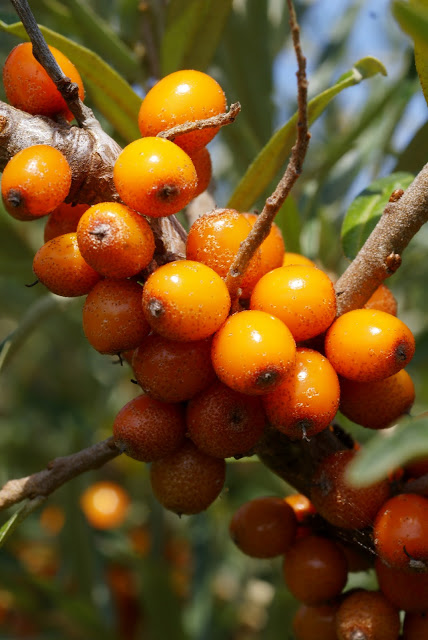
Sea-Buckthorn… this plant can do it all!
http://upload.wikimedia.org/wikipedia/commons/0/04/Hippophae_rhamnoides.jpg
Common Name: Sea-Buckthorn
Other Names: Seaberry, Sandthorn, Sallowthorn, Siberian Pineapple
Scientific Name: Hippophae rhamnoides
Other species: Himalayan/Willow-Leaved Sea-Buckthorn (Hippophae salicifolia)
Family: Elaeagnaceae (the Oleaster family)
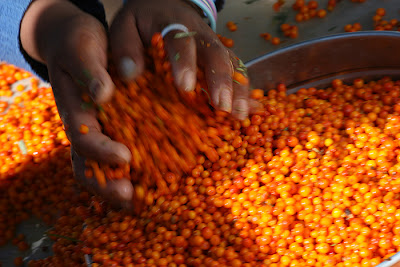
These small berries are best harvested by hand.
http://bluereview.files.wordpress.com/2010/08/india2009_jp11.jpg
Description:
Best known for their thorns, silvery-green leaves, and their bright orange berries (oval and just under an inch long), Sea-Buckthorns have a lot more to offer… edible berries that are very high in vitamin C and antioxidants, drought-tolerant, nitrogen-fixing, tolerates maritime environments, can form a fruit-bearing windbreak or living fence, has almost no pests or diseases, and requires minimal maintenance. I have not eaten or grown this plant yet, but I plan to if I can while I am living within sight of the ocean.
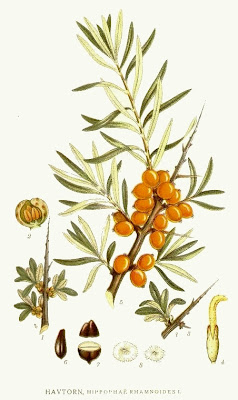
Hippophae rhamnoides
http://upload.wikimedia.org/wikipedia/commons/4/4d/243_Hippophae_rhamnoides.jpg
History:
Originating in Asia and eastern Europe, there are 7-8 Sea-Buckthorn species/sub-species. The Common Sea-Buckthorn (Hippophae rhamnoides) is by far the most widespread and cultivated. The vast majority of these plants are cultivated in China, and they are used due to their soil and water conserving properties. Many of the improved varieties of Sea-Buckthorn were developed in Russia.
Trivia:
- Sea-Buckthorn has not become more popular on a larger scale due to the difficulty with large-scale harvesting. The fruit does not come off easily with any mechanical means (pickers squash the berries and shakers can harvest less than half the ripe fruit), so the only good way to harvest is slowly with our bare hands… the old-fashioned way. Perfect for the home grower!
- Sea-Buckthorn berries contain one of the highest levels of vitamin-C (15 times that of oranges!).
- A beer named Tyrnilambic Baie d’Argousier from Brussels uses Sea-Buckthorn berries.
- The berries contain up to 9% oil (essential fatty acids… from a fruit!)
- Sea-Buckthorn is used in a lot of cosmetics
- Sea-Buckthorn has an extensive, tangled root system, so it has been used for soil restoration projects around the world
- The berry contains a single seed
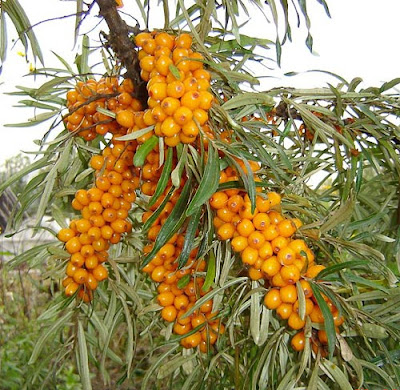
These small, tart berries are nutritional powerhouses.
http://www.agroatlas.ru/content/cultural/Hippophae_rhamnoides_K/Hippophae_rhamnoides_K.jpg
USING THIS PLANT
Primary Uses:
- Fresh eating – only certain varieties, as the fruit is very tart (very acidic); however, fruit that has undergone a frost is often sweeter, but the fruit is often past its prime
- Juice – often sweetened (sugar, honey) and even diluted with water (up to 5 parts water to 1 part Sea-Buckthorn Berry Juice)
- Cooking (i.e. sauces) – try to avoid overcooking as this will destroy the flavor
- Baking (pies, tarts, etc.)
- Preserves, Jellies, Jams, etc.
- Fruit Leather
- Flavoring component to Beer, Wine, Liquors, Cordials, etc.
Secondary Uses:
- Nitrogen fixing plant (puts nitrogen back into the soil) – inoculated with actinorhizal bacteria (Frankia).
- Windbreak (especially in maritime climates)
- Hedge/living fence
- Soil conservation
- Fall and Winter food for wildlife, especially birds
- General insect nectar plant (Spring)
- Small craft projects – fine grained wood
- Charcoal production
- Soaps, lotions, and other cosmetics
- Dye from the berries and sap
- A number of traditional medicinal uses
Yield: 20 pounds (9 kg) per plant
Harvesting: Late Summer-Early Autumn. Pick when the berries are bright orange and just starting to soften. The fruit does not fall off the plant until it is past its prime. The thorns can make harvesting difficult (i.e.painful!), so go slow. Some people will even clip berry-laden branch, stick it in the freezer for a few hours, and then easily shake the frozen berries off into a bucket.
Storage: Fresh for a few days. Frozen for a few months.
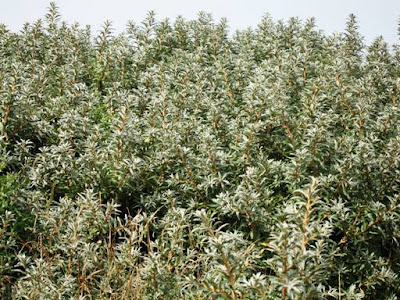
The dense, thorny, fast-growing hedge or windbreak can withstand salty winds.
http://www.chewvalleytrees.co.uk/i/products/00670_2/hippophae-rhamnoides-sea-buckthorn.jpg
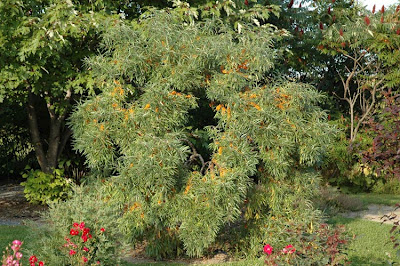
A single specimen in a garden – very pretty.
http://www.lejardindescuriosites.com/pages/dj/hippophae_rhamnoides_big.jpg
DESIGNING WITH THIS PLANT
USDA Hardiness Zone: 3-7
AHS Heat Zone: 8-2
Chill Requirement: Likely considering is origin, but no reliable information available
Plant Type: Large to Very-Large Shrub
Leaf Type: Deciduous
Forest Garden Use: Canopy Tree for small Forest Garden, Sub-Canopy (Understory), Shrub Layer
Cultivars/Varieties: Many varieties available.
Pollination: Dioecious (male and female plants); Need at least 1 male plant per 8-10 female plants for pollination. Appears to be pollinated primarily by wind.
Flowering: Spring.
Life Span:
Years to Begin Bearing: 2-3 years,
Years to Maximum Bearing: 3-5 years
Years of Useful Life: No reliable information, but as this plant suckers so easily, this should not be an issue… as one plant starts to diminish, we can allow and nuture a new sucker.
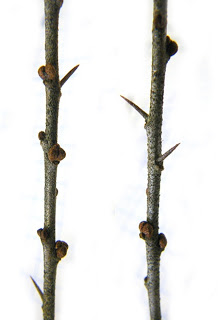
The thorns of Sea-Buckthorn are hard to spot with berries and leaves in place.
https://www.seabuckthorninsider.com/wp-content/uploads/2012/02/sbt-branches.jpg
PHYSICAL CHARACTERISTICS OF THIS PLANT
Size: 10-20 feet (3-6 meters) tall and wide; Hippophae salicifolia is taller, up to 33 feet (10 meters)
Roots: Suckering – new plants can grow from root shoots some distance from the trunk
Growth Rate: Medium – Fast
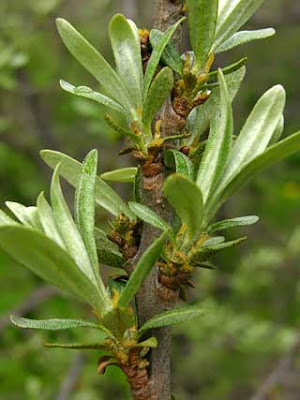
The very small flowers are green and resemble leaves.
http://www.luontoportti.com/suomi/images/2340.jpg
GROWING CONDITIONS FOR THIS PLANT
Light: Prefers full sun
Shade: Tolerates light shade, produces better in full sun
Moisture: Dry to medium, even wet if well drained
pH: tolerates a wide variety of soil (5.5-8.5)
Special Considerations for Growing:
- Tolerates a maritime environment well.
- Tolerates frost (especially the flowers in Spring).
Propagation: Usually from hardwood cuttings for true-to-type plants. Seed (needs 17 weeks of cold stratification).
Maintenance:
Minimal. However, since plants will fruit best on branches that are 2-years-old, regular pruning will increase yields, but it is not necessary. May need to prune back suckering roots to keep the plant under control… to keep it from forming a thicket.
Concerns:
- Sea-Buckthorn can spread fairly easily through seed or root suckering.
- Thorns can make it a hassle to harvest.

Widely known for juice, Sea-Buckthorn has many attributes making it worth growing.
http://hippophae.ru/images/cms/data/sok-1.jpg


I am first Iranian that posed this species. I had lecturer in India